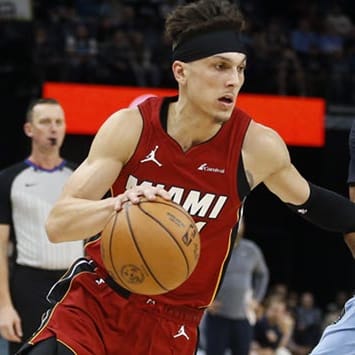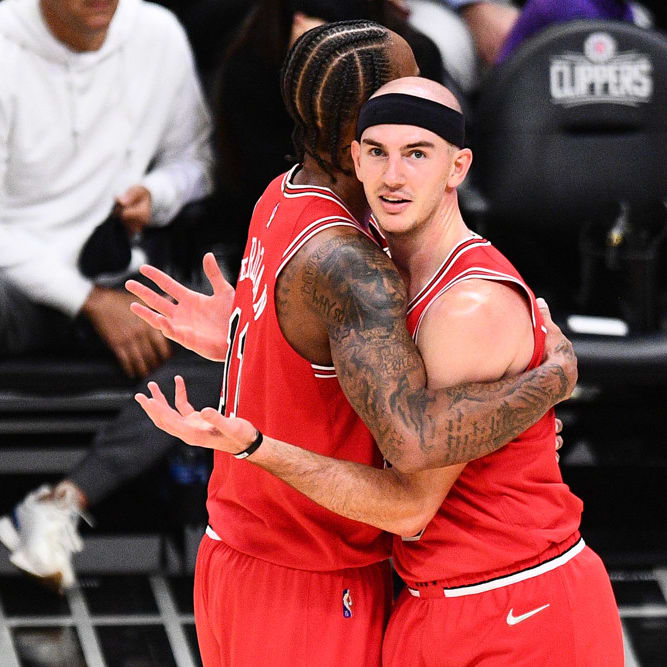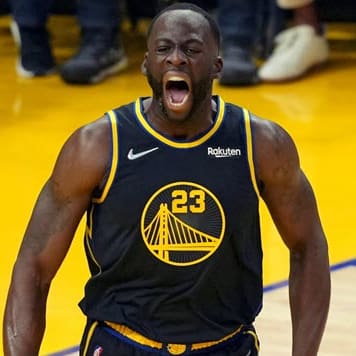This article is part of our Hoops Lab series.
Charles Barkley is the king of the "Barbershop Argument." From a few weeks ago:For those that have never been in a good barbershop argument, they tend to be decided by the guy with the most charisma who can spout off the quick resume bullet points the fastest while showing the most scorn that you (the opponent) would dare question his conclusion.
Barkley is the absolute master at this type of argument because he is charismatic, he has the most-watched NBA platform in the world with his TNT show, and he is legitimately one of the greatest basketball players that ever lived, so his word carries weight.
With that said, sometimes his arguments are idiotic. And the reasoning that he used when he stated that the '96 Bulls would kill the current Warriors was just that.
Now, this isn't to say that the '96 Bulls COULDN'T beat the current Warriors. They very well could have. But let's break the argument down a bit, go a bit beyond just barbershop spouting off and think about what such a match-up might look like.
Barkley statement, in an interview Thursday with ESPN Radio's Waddle & Silvy show in Chicago:
That Bulls team would kill this little team. Come on, man. Who is going to guard Scottie Pippen and Michael Jordan? What about Dennis Rodman?
First, that's a classic barbershop approach. This was his punchline, his leading argument, but if you look at it, what did he actually say? He name-dropped three Hall of Famers, said the Warriors couldn't guard them and charismatically put scorn in his voice as he said it. Well done. But if you actually think about it, the current Warriors are better built to defend those Bulls than any team was in 1996.
One of the innovations of those Bulls teams was that they were one of the first to stack up on the 6-foot-6 and 6-foot-8, athletic, versatile players who could impact the game in so many ways. It was rare in those days to have a single player of that size and athletic ability who could do everything. Before Jordan's time, players in that ability range were typically forwards who were more finishers than all-court players. Shooting guards were typically more in the 6-3 to 6-4 range and shooters. That's why, if you think back, many of Jordan's defining series came against the 6-3 Joe Dumars, 6-4 Gary Payton, 6-3 John Starks and 6-4 Jeff Hornacek; there weren't a lot of guys built like Jordan who were capable of playing the wing like he did. And with Scottie Pippen (and to a lesser extent the aged Ron Harper), the Bulls actually had three players like that.
But in the post-Jordan era, because everyone wanted to "Be Like Mike", pretty much ALL 6-6 to 6-8 players modeled their games after Jordan. They all wanted to be do-it-all wings instead of their more traditional forward approach. So by the time that you get to the 2015 Warriors, you find that they have an entire squad of guys of the size/athletic ability ratio to face off with those Bulls. The Warriors' wing rotation of 6-8 Harrison Barnes, 6-7 Klay Thompson, and 6-6 reigning NBA Finals MVP Andre Iguodala would match up with the Jordan/Pippen combo in a way that NO team in 1996 was capable of.
And while Rodman was amazing, he was an undersized 6-7 who made his money by being tough enough to bang with bigger players while being way quicker and more athletic. Rodman, meet Draymond Green. Game on.
Barkley Statement:
Michael Jordan, Scottie Pippen and Dennis Rodman -- let me just start with those three. First of all they would love playing the way the Warriors play. It's a much easier game now. Could you imagine how many points Michael would average if you couldn't touch him? Dennis would get so many rebounds against that team. They are a very small team.
Let's look at the last two sentences first. This is another over-simplistic statement that Barkley just couldn't have put much thought into before saying it. The '96 Bulls were one of the templates for the modern small-ball era. They started four players between 6-6 and 6-7, plus a giant center as a body/six fouls for teams with more traditional scoring bigs that were more prevalent in the '90s. However, a lot of their success came from the fact that their speed/athleticism created mismatches and opponents couldn't take advantage of it even with greater size. This is like Page 1 of the small-ball manual. In fact, let's look at the sizes of the two starting line-ups:
Bulls: Ron Harper (6-6), Michael Jordan (6-6), Scottie Pippen (6-7), Dennis Rodman (6-8), Luc Longley (7-2)
Warriors: Stephen Curry (6-3) Klay Thompson (6-7), Harrison Barnes (6-8), Draymond Green (6-8), Andrew Bogut (7-0)
Those lineups are extremely similar in size, and they even both start an Australian center. Perfect.
Of course, the Warriors only play Bogut (or Festus Ezeli) for short periods, and they make a lot of progress with their undersized lineups featuring Iguodala and/or Shaun Livingston in place of the center. Yes, the Bulls team would be bigger than that lineup if they left their starting unit out there. But here's the thing: the Bulls COULD NOT leave their starting lineup out there against that squad. Longley (or Bill Wennington) would get absolutely SMOKED at both ends of the court if they tried to stay out there for that track meet. They would get pick-and-rolled all the time on defense, and even if they helped generate more offensive boards, the Warriors would be getting 3-pointers on the lion's share of those possessions, which would force the Bulls to counter by going small themselves with Toni Kukoc replacing the center. So no, size wouldn't be the issue.
Barkley Statement (re-stated):
First of all they would love playing the way the Warriors play. It's a much easier game now. Could you imagine how many points Michael would average if you couldn't touch him?
"It's a much easier game now" is a classic ex-athlete/barbershop-level throwaway line. Because, like everything, it cuts both ways. Yes, Jordan would be more effective offensively with no hand-checking. However, those Bulls won just as much with their No. 1 rated defense as with their offense. And the Bulls' defense was built outside-in, predicated on having a bunch of physical 6-7 athletes that could punish the opposing perimeter players while still having the length to help down on opposing bigs and switch on most picks with tight rotations. Again, they were a predecessor of a lot of the current approaches. However, what happens to that Bulls defense against this Warriors offense when they can't hand-check anymore?
Those Bulls already could be given fits by small, quick point guards. They weren't built to defend them, as neither Harper nor Jordan had the foot speed to keep up with them. They managed because a) most of the point guards on good teams were more distributors than scorers (or at least they couldn't be the primary scorer in a shootout against Jordan) and b) the slower Bulls were allowed to hand-check/manhandle those smaller guards to prevent them from getting where they wanted to go. Now ask yourself: what are they going to do with a small, quick point guard that can (and consistently does) drop 40+ points on ridiculous efficiency while operating outside the 3-point line where he can't be touched? Curry would tie either 32-year-old Harper or 33-year-old Jordan in knots on defense and would break down the Bulls' entire defensive approach because he would force them to over-help, which results in open looks for the other shooters.
Also, Chuck, what would '96 Rodman do on defense against these Warriors? 1991 Rodman, ok, it'd be on. He was hyper-athletic and hyper-aggressive on defense, and he could have given Draymond Green fits while defending the pick-and-pop game excellently. But by 1996? Rodman's ENTIRE game was about rebounding, at both ends of the court. He was no longer a lock-down defender who would venture out to the perimeter to defend everyone, at least not with any consistency. But no matter who he guarded in the Warriors small-ball approach, the greatest rebounder of all-time would have to spend a bunch of his time far away from where he was most effective.
It'd be great to have a time machine and let that matchup really play out, but until that technology becomes available, the best we can do is play the what-if game. But the '96 Bulls against the '15 Warriors would be one HECK of a what-if, and certainly deserves more thought than what you could get in any barbershop in America. Chuck, that argument of yours was turrble.
Around the NBA
Davis' poo game:Anthony Davis has been in this space a few times for his apparent fragility, which causes him to leave/miss games at inopportune times. Sunday was another example, though if you only looked at the box score you would have no idea. Davis started off the game on fire, scoring 19 points in the first quarter before sitting out the entire second and third quarters and not returning until later in the second half. Where did he go? Well, apparently he had the flu. There are reports that he was dehydrated and throwing up and required four IVs before he could return. Davis ended the game with 27 points, six boards and four blocks in just 20 minutes while leading the Pelicans over the Nuggets in his very own "flu game." However, with the rumors that Davis' flu manifested…out of both ends…@DerektheMerican had a funny take on what he would call this game:
Michael Jordan had his "flu game" could this be Anthony Davis' "poo game"? Stay tuned to @FOXSportsNOLA to find out!
— Derek (@DerektheMerican) December 21, 2015Paul rounding into form:Chris Paul started off the season very slowly, as injuries robbed him of explosiveness and caused him to play at a more pedestrian pace. While peers Stephen Curry and Russell Westbrook were dominating the early part of the season, Paul has been sliding down the rankings. But he finally seems to be rounding into form as his health improves, averaging 18.8 points, 10.9 assists, 2.5 steals and 1.9 treys per game over the past two weeks.
Durant has humanized Westbrook: Speaking of Westbrook, Kevin Durant's return has done what no defense has been able to figure out how to do for the past year: slow down Westbrook.
Side note: do you ever actually watch Westbrook play? He doesn't look like he's playing the same speed as everyone else; it's like he's been shot out of a cannon or something.
Well, Durant's return has made Westbrook more human. After averaging 26.0 points, 9.9 assists and 7.6 boards in 33:32 minutes per game in November (often without Durant), Westbrook has only averaged 21.5 points, 8.7 assists and 5.7 boards per game in December (with Durant back full time). Westbrook's shooting efficiency has surprisingly dropped in December (45.2 percent from the field, down from 46.4 percent), though his turnovers are down drastically (5.3 turnovers per game to 3.1). which indicates that he isn't forcing it nearly as much.
Kyrie's return kills Love? On the RotoWire Fantasy Sports Today show on Monday, hosts Chris Liss and Jeff Erickson asked me whether Kryie Irving's return from his knee injury would kill Kevin Love's production. They pointed to Irving's debut on Sunday when Love took a season-low four field-goal attempts as evidence. While a healthy Irving obviously will take a large chunk of offensive stats, likely as the second-highest usage player on the team, Sunday's game wasn't evidence of Love's death knell, as it was a blowout win over the hapless 76ers in which Love only played 21 minutes. Love has only taken 13.4 field goals per game this season anyway, a number that should be sustainable even with Irving's return. And if that number drops slightly but Love is still able to grab double-digit boards and knock down more than two treys per game, he would still maintain the lion's share of his value.
Wall's ribs and Porter's thigh:John Wall injured his ribs at the end of Monday night's win over the Kings, but he still expects to play Wednesday against the Grizzlies. Meanwhile, Bradley Beal remains out indefinitely with a stress reaction in his leg and now Otto Porter is dealing with a thigh issue that has kept him out of two straight games. The Wizards need Wall to play through his pain, but DFS players should pay attention to Garrett Temple as a potential value pick while injuries are eliminating the other Wizards wings.
Millsap's ankle:Paul Millsap tweaked his ankle Monday against the Trail Blazers, which limited him to just 25 minutes. The extent of his injury isn't known yet, so for now he is considered questionable for Wednesday's game.
Limping Trail Blazers backcourt: Both Damian Lillard and C.J. McCollum missed Monday's game due to injury. Lillard has been playing through plantar fasciitis and may have to sit out for a couple more games before he returns. McCollum is out with a sprained ankle but says he will be back soon. In their absence, Alan Crabbe and Gerald Henderson both played solid games Monday.
Sully and Johnson out: The Celtics' starting frontcourt is injured, with Jared Sullinger dealing with back issues and Amir Johnson battling plantar fasciitis. This has opened the door for Kelly Olynyk and David Lee to move into the starting lineup. Both scored in double figures Monday, getting themselves on the short-term fantasy radar.
Valanciunas nearing return:Jonas Valanciunas has returned to practice after recovering from his hand injury, and he could return to the court as soon as the end of the week. In his absence, Bismack Biyombo had proven himself to be a rebounding machine, but when Valanciunas returns he will a majority of the minutes at center for the Raptors.
Got the drank in me going back-to-back: Back-to-backs 12/22– 12/29
MT: None
TW: Mavericks, Nuggets, Pistons, Lakers, Grizzlies, 76ers
WT: None
TF: None
FS: Bulls, Cavaliers, Rockets, Clippers, Heat, Pelicans, Spurs
SS: Celtics, Nuggets, Grizzlies, Knicks, Trail Blazers
SM: Lakers, Kings
MT: Hawks, Cavaliers, Heat, Bucks
New Additions and DFS value:
Lou Williams (63 percent owned in Yahoo! leagues): Williams' ownership percentage is higher than I typically include here, but I wanted to give him a shoutout as quite possibly the most consistent Lakers producer even though he comes off the bench. Williams averaged 15.5 points on 48 percent shooting from the field and 82.6 percent shooting from the line with 1.9 treys and 1.4 steals per game over the past month, and he has scored at least 14 points with at least one 3-pointer in nine straight games.
Kelly Olynyk (17 percent): Olynyk is a good per-minute player who has had a few big games off the bench, but in the short-term with Amir Johnson and Jared Sullinger both injured, Olynyk is getting the chance to play. He started Monday and responded with 19 points (shooting 70 percent from the field), three 3-pointers and five boards in 29 minutes.
Alan Crabbe (12 percent) and/or Gerald Henderson (three percent):Damian Lillard (plantar fasciitis) and C.J. McCollum (ankle) both missed Monday's game, leaving the opportunities to Crabbe and Henderson. The injuries to the starters are considered minor, so both are likely to return soon, but in daily leagues Crabbe (who had 19 points, four rebounds, two assists, a block and a trey in 32 minutes in a start Monday) and Gerald Henderson (12 points, four assists, three boards and a 3-pointer in 26 minutes) are both worth looks in DFS games.
James Johnson (three percent): Johnson is one of my favorite DFS value picks when he's gotten minutes over the past two years because of the consistent fantasy production. This year has been no different, as in two games since taking over as the starter for Terrence Ross (who was taking over for the injured DeMarre Carroll) Johnson has averaged 13.5 points, 3.5 rebounds, 3.0 assists, 1.5 steals, 2.0 blocks and 0.5 3-pointers per game.
Channing Frye (three percent): Frye hits 3-pointers; that's what he does. Recently he has started getting minutes again (about 25 per game in his last five), and in that stretch he has knocked down 11 3-pointers with three double-digit scoring efforts and a few other miscellaneous stats as well. But it's the 3-pointers from the big man that makes him an interesting pick-up.
Garrett Temple (two percent): Temple is more DFS value than necessarily a New Addition because he has only been getting minutes due to injuries to Bradley Beal and Otto Porter. Both should be up to speed soon, which would send Temple back to the bench. But in the meantime, he has averaged more than 38 minutes per game over the last two and has responded with back-to-back 20+ point scoring efforts to the tune of 22 points, five rebounds, three assists, two steals and 3.5 treys per game.












